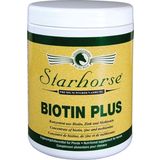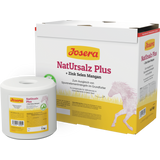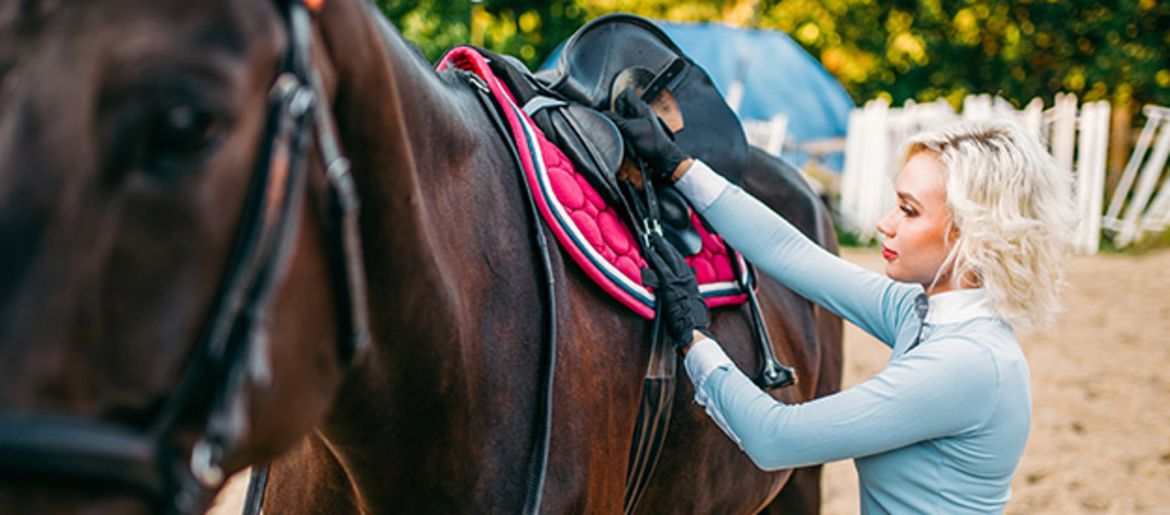Proper Saddling of a Horse
Saddling is a very important part of horse riding and if you're not sure what to do or how your saddle should be placed on the horse, mistakes can quickly creep in. You could use a saddle that does not fit well and causes pain.
But not to worry! This article guides you through the individual steps so that even beginners can saddle their horses safely!
Before Saddling: Clean the Horse
To avoid possible chafing, it is important that you clean your horse's back and girth area well. The coat should be free of dirt and sand, as this could cause irritation to the skin under the saddle. Before saddling up, especially check the withers, the belt area and the area behind the elbow. These are the most sensitive areas.
Position the Saddlecloth and Saddle
First of all, you need to make sure that the saddlecloth fits well under the saddle, so position it correctly. Sometimes this is not that easy and requires a little practice. There are saddlecloths that are attached directly to the saddle and some where this is not possible. In the latter case, you can place the cloth around the neck from the left so that around half of it is in front of the withers. Make sure that the saddlecloth is even and wrinkle-free everywhere before you put the saddle on.
If the saddlecloth is attached to the saddle, place both around 20 centimetres in front of the horse's withers.
The saddle is correctly placed when the middle of the cloth meets the chamber of the saddle at the top and the centre of the cloth should also be below the centre of the saddle at the back.
Now push both backwards until it is on the lowest point of the back. The advantage of pushing back the saddle and blanket is that the coat lies smoothly under the saddle, making it more comfortable for the horse.
If the horse is standing normally and the leading edge of the blocks has two fingers or more space to the shoulder blade, the saddle is in the correct position.
Tighten the Girth
Now it's time to tighten the girth. Again, pay attention to the correct position. If the belt is in the narrowest part of the abdomen (about a hand's breadth behind the front leg), it is correctly seated. (Incidentally, the saddle should not be much further back, otherwise it presses on the lumbar area, which is very uncomfortable for the horse.)
Before fastening, take a quick look at the right side of the horse. Check that everything is in place. Is the saddlecloth right? Is the leading edge of the cloth pressing on the withers? If so, please adjust.
Then take the saddle girth and let it hang straight down. Now we go to the left side again, where we grab the belt from under the abdomen and then fasten it. Use only the first hole to start with and then check everything again. (The importance of this point cannot be stated enough. Carelessness and small mistakes can always creep in, which can then have painful consequences for horses and riders.) If everything fits, tighten the belt gradually until correct.
How Tight is Too Tight
Tightening the girth firmly, in this case, means that you are tightening the belt with normal force. If you can still slide two fingers between the saddle girth and the body, that's ideal.
Don't Forget to Retighten
Now nothing stands in the way of a ride. Remember, however, that you should retighten the belt after about 10 minutes. As always, do not pull the belt too tight, otherwise the horse will not get enough air and may also be in pain.
Saddle Pads and their Corrective Properties: The Friend of the Sensitive Horse?
A horse is a large animal that can feel the smallest of things, like an annoying fly on its back. If such a little thing bothers you, you can imagine how much it can be bothered by pressure points or imbalances in the saddle! This is where corrective saddle pads come into play, which can help your sensitive friend with his problem areas.
Saddle pads for correction are a necessity for anyone who is not lucky enough to have a perfect fit. They help relieve pressure points, balance the weight of the saddle and absorb shocks while riding.
Saddle pads have been specially developed for correcting the rider's position and are available in many different designs and made of different materials. Some are made of felted wool, while others are made of foam. There is also an abundance of designs that can be used for different needs such as English saddles or western saddles.
A correction pad helps the horse by supporting it where it needs more padding than normal - e.g in the spine area when ridden upright - or by correcting fit problems such as girths that are too far back or forward in the ideal position on the animal's shoulders, which would lead to inadequate weight distribution for rider and horse during long rides together through rough terrain.
You can browse our range of saddle pads here.
Latest reviews
-
 4.8 (4)
4.8 (4)Starhorse Biotin Plus, 550 g
-10%- Biotin, Zinc & Methionine
- Slightly sweet taste
- With vanilla flavour
€ 26,95 € 29,99 (€ 49,00 / kg)Delivery by April 17
-
 4.0 (1)
4.0 (1)Josera NatUrsalz Plus - Horse Lick, 5 kg
-10%- Can be used in organic farming
- Salt lick with zinc, selenium & manganese
- High acceptance
€ 6,74 € 7,49 (€ 1,35 / kg)Delivery by April 17
-
 4.6 (71)
4.6 (71)GladiatorPLUS Gladiator Plus Horse, 1.000 ml
- Excellent ingredients
- High bioavailability
- Sugar-free
€ 91,99 (€ 91,99 / l)Delivery by April 17
-
 3.7 (3)
3.7 (3)leovet Milton White "Grey Shimmer", 550 ml
-10%- Fights discolouration
- Brilliant white effect
- Made with natural proteins
€ 15,25 € 16,99 (€ 27,73 / l)Delivery by April 17
